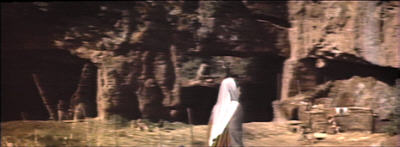
This section of the web site could be eliminated entirely because of the newest DVD release of Ben-Hur but the Curator retains it for informational purposes. A review of the new DVD can be found elsewhere on the site. If you don't own the 2005 DVD set of Ben-Hur then go buy it right now. |

MGM Home Video offers the most extreme case of letterboxing with their laser disc set of Ben-Hur. The film was produced in MGM Camera 65, (later known as Ultra Panavision 70), and the maximum aspect ratio was 2.76:1 because the standard 2.21:1 65mm/70mm aperture was used in combination with anamorphic lenses having a modest compression of 1.25X. The video has an aspect ratio of 2.75:1, even though the packaging says the film is in the "correct" 2.66:1 ratio. The image above is taken from the laser disc.
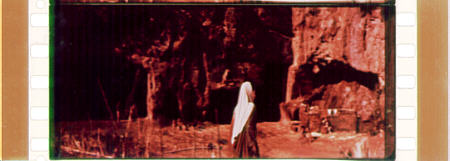
Here is the same frame, taken from an original 1959 70mm print of Ben-Hur. The slight squeeze imparted by the Panavision built lenses is apparent.
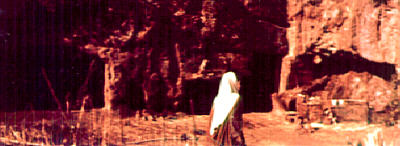
Expanding the portion of the frame specified by industry standard aperture dimensions, we would see this image projected on the screen.
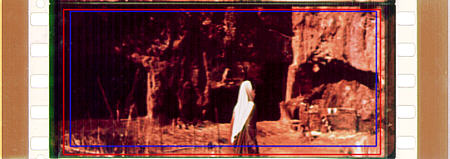
Indicated by a red rectangle is the projector aperture dimension, and in blue, the image area copied to the letterboxed video. If this film had been produced in Todd-AO or Super Panavision 70, the transfer might be considered flawless. The use of the upper portion of the frame for the transfer is generally a good practice to protect actor's heads, their feet are more expendable. However, since the original film is anamorphic, the correct extraction area for 35mm prints, (the source of the final video in most cases), should be slightly less horizontally and slightly more vertically. This error results in a video that uses a very small percentage of the valuable television screen real estate.
|
|
|
|
|
|
|
|
|
|
|
|
|
|
|
|
|
|
|
|
The low resolution resulting from the tiny letterboxed image in the "deluxe" set makes for a very unsatisfactory viewing experience even on the biggest, best projection systems available. A clue to how much better if could have been is included in the set itself, as seen in the frame below.
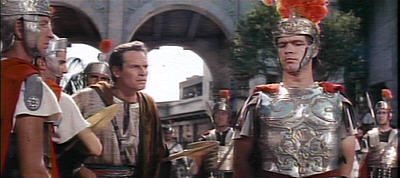
This frame is taken from the trailer included in the disc set. The trailer was printed by Technicolor in 1960, using the correct extraction method. There is a slight cropping of the sides in the video, but the substantial increase in image clarity comes as a shock after suffering through 217 minutes of overdone letterboxing. Even the poor quality frame grabs used in these illustrations makes the difference in the screen image obvious. The slight loss of width is more than compensated for in increased detail. Since the early 1970's all 70mm prints of Ben-Hur have been made optically to conventional 2.21:1 spherical prints. If that aspect ratio is acceptable on a giant screen then why was it necessary to produce a video at 2.75:1? Video magazines! Well, maybe one of these days...
The new DVD Release from Warner Home Video is superb. While the curator would have sacrificed a tiny bit of image width in order to get a higher resolution image, this new release has been handled in the WHV Ultra Resolution system that ultimately creates new archival film masters and is the source for current DVD and any future formats that offer higher resolution.
©1997 - 2000 The American WideScreen Museum
http://www.widescreenmuseum.com
Martin Hart, Curator